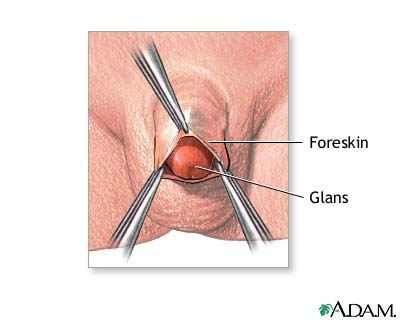Circumcision - surgical removal of the foreskin

What is Circumcision
Circumcision - the surgical removal of the foreskin (prepuce), the thin hood of SKIN that covers the end of the PENIS. The reason for circumcision may be therapeutic, religious, ceremonial, hygienic, cultural, or social. About two thirds of newborn boys in the United States are circumcised shortly after birth for nontherapeutic reasons. Nontherapeutic circumcision should take place within three weeks of birth when done in infancy. Circumcision at an older age, and particularly in adulthood, becomes a more significant surgical procedure with increased risk for complications.
Infant (Neonatal) Circumcision
For infant circumcision, the doctor applies an anesthetic cream or injects a local anesthetic to numb the penis, then applies a circumcision clamp and cuts away the end of the foreskin. The procedure takes about 10 minutes. Some methods leave a plastic ring around the penis that seals the edge of the wound; the ring falls off when the wound heals (within 7 to 10 days). There are no sutures (stitches). Minor bleeding for a day or so after the procedure is common.
Adult Circumcision
Adult circumcision is a minor surgery OPERATION generally performed in a hospital operating room or an aMBULATORY SURGERY FACILITY; it requires regional anesthesia (anesthetic injected into the NERVE that serves the penis) and a general sedative. The circumcision operation takes about 30 minutes; typically a urologist performs the operation. Sutures remain in place for five to seven days after the operation. It is important to try to avoid erections and sexual activity for four to six weeks to allow the surgical wound to heal properly. There is often mild to moderate discomfort during HEALING; the doctor may prescribe or recommend ANALGESIC MEDICATIONS for PAIN relief.
Risks and Complications
Risks associated with circumcision include excessive bleeding, injury to the penis, too much or too little foreskin removed, and postoperative INFECTION. Infants who have a CONGENITAL ANOMALY of the penis such as HYPOSPADIAS or CHORDEE should not undergo circumcision. Health conditions for which circumcision is therapeutic include PHIMOSIS and PARAPHIMOSIS, conditions in which the foreskin does not properly retract or return to its normal position, and chronic or persistent BALANITIS (an infection of the glans that develops under the foreskin).
Medical Debate about Routine Infant Circumcision Despite its frequency, routine infant circumcision is a matter of considerable debate among health professionals. In 1999 the American Academy of Pediatrics issued a position statement that there are no medical or health reasons for routine circumcision of newborns. Numerous studies have attempted to determine whether circumcision provides health benefits. The findings are mostly inconclusive, with the exception of a significantly increased risk in uncircumcised boys for URINARY TRACT INFECTION (UTI) during early childhood. Uncircumcised men are more likely to acquire infections such as balanitis and perhaps SEXUALLY TRANSMITTED DISEASES (STDS) such as HUMAN PAPILLOMAVIRUS (HPV) and HIV/AIDS. Circumcision does not provide protection against such infections, however.
See also CANCER OF THE PENIS; CULTURAL AND ETHNIC HEALTH CARE PERSPECTIVES; SURGERY BENEFIT AND RISK ASSESSMENT.